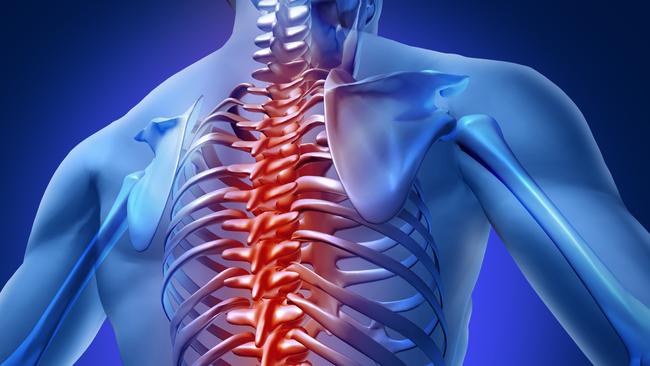Stem cell injection better than placebo for back pain
A SINGLE injection of six million stem cells into a degenerative spinal disc can reduce back pain, opioid reliance and the need for invasive spinal surgery for at least two years, early trial results show.
VIC News
Don't miss out on the headlines from VIC News. Followed categories will be added to My News.
A SINGLE injection of six million stem cells into a degenerative spinal disc can reduce back pain, opioid reliance and the need for invasive spinal surgery for at least two years, early trial results show.
The Melbourne-developed treatment, an off-the-shelf stem cell product that can treat 20,000 patients from cells grown from one healthy young person, is being tested as part of an international trial.
Back pain is the most common cause of disability worldwide, with a quarter of cases caused by degenerative spinal disc disease.

This can occur when the cushions between vertebrae are injured, but spinal discs also dehydrate — just like the skin wrinkles — as we age.
The treatment from regenerative medicine company Mesoblast is the result of 10 years of research at Monash University and Hudson Institute of Medical Research.
The 100-patient, double-blinded phase II trial found a greater proportion of those treated halved their pain level compared to a placebo a year after treatment. It also reduced the need for pain relief and other surgical interventions.
But orthopedic surgeons not connected to the study say the proof lies in phase III, as the current study — which measured safety and efficacy — did not show meaningful real-world benefit.
The principal investigator of the Australian trial site, neurosurgeon Associate Professor Tony Goldschlager, who is on Mesoblast’s scientific board, said the stem cells were believed to work in three ways.
“The stem cells themselves are important anti-inflammatory agents,” he said.
“They also trigger the body’s own cells, which are asleep in a dehydrated disc, to start working.
“The disc works by producing proteins that attract water. When the cells don't work properly, they can’t use those proteins, and the discs lose their shock-absorbing capacity.”
Already, 300 people have been enrolled in the phase III trial, due to finish this year.
Associate Prof Goldschlager said given current treatments for back pain, such as exercise, epidural steroid injections, surgery and pain medications had varied effects, new treatments were needed.
“It’s very hard to work out where the pain generator is with back pain,” he said.
“We don’t know yet if the benefits of the stem cells will carry on for five or 10 years. But even if it only lasted for two years, an injection every two years is better than all current alternatives.”
Melbourne orthopedic spinal surgeon John Cunningham said there was a “theoretical place for stem cell treatments” for disc degeneration, and phase III results would determine their worth.
“While there are significant differences between the saline placebo and treatment in phase II, the changes at this point are too small to be clinically relevant,” Mr Cunningham said.


